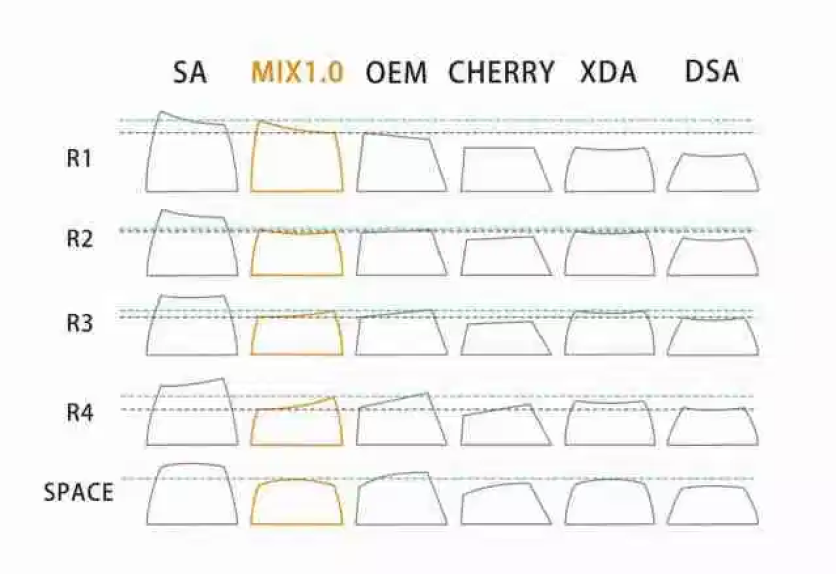plate
keycap
switch
guide_
key switch buying guide
Underneath each key of a mechanical keyboard is a mechanism called a switch that registers the keystroke. These switches have a variety of response, noise, and travel times, which make them attractive to gamers, coders and/or typists.
Type indicates the type of the switch. There are three things to consider when choosing your switches: 1) Auditory feedback, with or without a clicky sound. 2) Tactile feedback, a smooth or clicky key press. 3) The force needed to activate the switch.
Pre travel, measured in millimetres, indicates the distance needed to activate the switch. Less distance, faster switch. Total travel, indicates the total travel of the switch.
Operating force, measured in grams of pressure. Lower pressure means less force to activate the switch.
Keycap buying guide
The keycap profile refers to the overall shape of the keycap, some keycaps are flat, some are rounded, with many different shapes as well. There are certain styles in which each row of keys has a different height to allow for a concave or sloped shape over the entire keycap set.
By changing the shape of your keycaps, it lets you take the style and feel of your keyboard to a whole new level. There are several different profiles and shapes of keycaps to select from. There are many more profiles as well, they are just more uncommon are harder to get ahold.

Profile types
| Keycap Profile | Description |
|---|---|
| OEM | The keycap profile you’ll find on most keyboards. Mass produced, considered standard. Angled top. |
| Cherry | Very similar to OEM profile, but shorter. Very popular layout. |
| DSA | Slightly shorter profile with spherical top. |
| XDA | Medium height profile with spherical top |
| SA | Tall height profile with slightly spherical and angled top. |
Plate buying guide
Besides keeping the switches aligned, one of the primary purposes of the plate is to alleviate stress from the PCB and provide a more consistent and firm typing feel. In plateless builds, the stress of bottoming-out is directly on the PCB, and without the reinforcement of a plate, it allows for a more bouncy and flexible typing experience. The addition of a plate creates a more rigid feel and also affects the sound signature depending on the material of the plate.
SIZE

MATERIALS
STEEL
The vast majority of switch mounting plates are made of steel. To prevent rusting, they are typically painted. The metal is typically thick enough that even when the plate does develop rust patches, it can be cleaned up and repainted.
ALUMINUM
Aluminium is a popular choice for enthusiasts. It was also used occasionally by commercial manufacturers. Wong’s Electronics of Hong Kong used aluminium mounting plates on BBC Micro keyboards, which reduced the weight of the computer in comparison to batches produced with steel-plate keyboards from SMK and PED. Aluminium is less rigid than steel, which some people feel makes keystrokes a little softer. No examples of a double-blind test of steel versus aluminium plates are known, that would verify whether aluminium does offer any kind of perceivable improvement, but it does have the advantage that it will not rust.
PLASTIC
Some low-cost keyboard manufactuers opted for plastic plates in the 1990s. These included Acer (some 631x keyboards had a fully discrete plastic plate), Tai-Hao (as found in some models of TH-5539 keyboard) and Nan Tan Computer, as found in their cheaper KB-625x models. Plastic plates cut down some of the noise produced by mechanical switches, which some people may find preferable, and they will not rust.